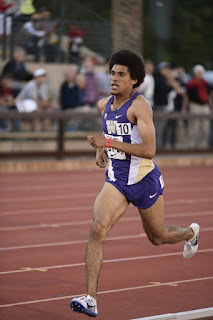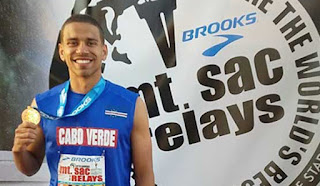Why May 12th will always be a special day...
 I wonder what my life in this sport would be like if I had missed out on May 12, 1984?
I wonder what my life in this sport would be like if I had missed out on May 12, 1984?Every 12th of May, I pause for just a moment to reflect and thank my lucky stars for two events that happened on the same day some 60 miles apart.
In 1984, I was the assistant to the director of communications for the local organizing committee staging the marathon trials in Olympia, working under a very savvy media relations director, Jeanne McKnight, a woman who I consider to this day as one of my mentors.
Having lost my job with a small Seattle advertising agency where I was supposed to drum up new clients (and not having the first clue on how!), I figured that working there in the mornings before going to my job coaching the distance runners at Ballard High School would be a great way to go back to what I really loved, and that's writing about the sport.
I was essentially the stats guru for the local organizing committee, as a week or so after I took the position, I brought into the office several years' worth of Track & Field News magazines, and other periodicals (remember kids, this was before Al Gore invented the internet!).
While many of the staffers and volunteers that worked with us were involved because of the historical aspect for women's sports, I was involved because it was the Trials, and I saw the dramatic effect and cut-throat nature of the Olympic Trials--it's top three or go home!
I wrote many of the athlete bios for the organizing committee that we used in our media packets, and eventually my role was expanded, as I was the liaison to television rights holder ABC Sports.
In Olympia, Joan Benoit (above/photo courtesy IAAF) overcame the odds of having arthroscopic knee surgery three weeks earlier to win the first US Olympic Marathon Trials in a time of 2:31:41 over the 26.2 mile course that looped around the cities of Lacey and Tumwater before finishing on the shores of Marathon Park, slightly south of the state capitol building.
Benoit led 195 other women across the line, including Olympic teammates Julie Brown (2:31:41), and Julie Isphording (2:32:26).
Benoit, the holder of the world's best time in the event, would go on to make history three months later when she won the first Olympic gold medal in the marathon, crossing the finish line at the Los Angeles Memorial Coliseum in 2:24:52, more than a minute ahead of Norway's Grete Waitz and Portugal's Rosa Mota, who would win it four years later in Seoul.
As I wrote in my recap of the 1984 Olympic Marathon Trials for MARATHON, the Olympia local organizing committee's newsletter, "The race field was the deepest in the history of women's marathoning…Olympia's fast course yielded the most performances under 2:40 (31-old record 17 at Helsinki World Championships); most under 2:45 (64; old record 29 in 1983 NYC Marathon); and most sub 2:50 performers (109; old record, 44, 1983 NYC Marathon)."
To this day, none of the US Olympic Marathon Trials races have eclipsed Olympia for its depth.
Two years ago, I was interviewed by Running Times' Michael Musca about the event. Here's his historical recap of the race, which you can read here.
 Back in Seattle at Husky Stadium, another event that had a profound effect on my life in the sport took place, as a 16-year old junior at Franklin High School by the name of Rick Noji (left/photo courtesy Seattle Times) made national headlines when he high jumped 7-4 1/2 inches (2.25m) to set the all-time Washington state record in that event.
Back in Seattle at Husky Stadium, another event that had a profound effect on my life in the sport took place, as a 16-year old junior at Franklin High School by the name of Rick Noji (left/photo courtesy Seattle Times) made national headlines when he high jumped 7-4 1/2 inches (2.25m) to set the all-time Washington state record in that event.My involvement with Rick began a year earlier, thanks to one of his teammates at Franklin, Doug Muneta, who happened to be my neighbor.
Being that I had some knowledge of the sport at the regional and national level, Doug introduced me to Rick, who occasionally played in our neighborhood street football games.
I eventually ended up helping advise Rick and his family on various aspects of the sport, and doing some of his media relations work, particularly during his senior year at Franklin, where he had numerous media outlets asking for his time, while dealing with the recruiting pressures, all of which were uncharted territory for him and his coach (and my former high school coach), Don Bundy.
That jump, which won the Seattle Metro League title, earned Noji a spot to compete in the US Olympic Trials in Los Angeles, where he was one of four high schoolers competing at the the Coliseum for a spot on the Olympic team.
I heard about Rick's historic jump from SPU coach Doris Heritage at the post-race athletes dinner party at St. Martin's College. I immediately got on the phone to Rick and congratulated him on his jump, and asked if he and his parents could drive down to Olympia to meet a few people, including marathon guru Dr. David Martin (who, coincidentally, had just written a technical book on the high jump with Dwight Stones, Greg Joy, and Jacek Wszola), and several people from Nike, which had started providing him with equipment a few weeks earlier.
The 5-8 Noji eventually attended the University of Washington, where he won the 1990 Pac-10 high jump title, and set their school record of 7-6 1/2. He made three USA world championship teams in the 1990s, competing in Tokyo in 1991, where he placed eighth, and Stuttgart in 1993 and Goteborg in 1995.
When he ended his career after the 1996 Olympic Trials in Atlanta, he left with a personal best of 7-7.
Noji will be inducted into the WIAA Hall of Fame on Wednesday May 12, 2010, 26 years to the day of his jump at Husky Stadium, along with legendary prep coach Frank Ahern, who was an influence on both coach Bundy and myself.
Without those two events, I honestly don't think I would be involved as extensively in the sport of track and field as I am today. The events of May 12, 1984 opened up numerous doors and opportunities for me. I'll always be grateful to Jeanne McKnight, Rick Noji, Joan Benoit, and the countless friends and associates I've met over the years because of those two events.


Comments